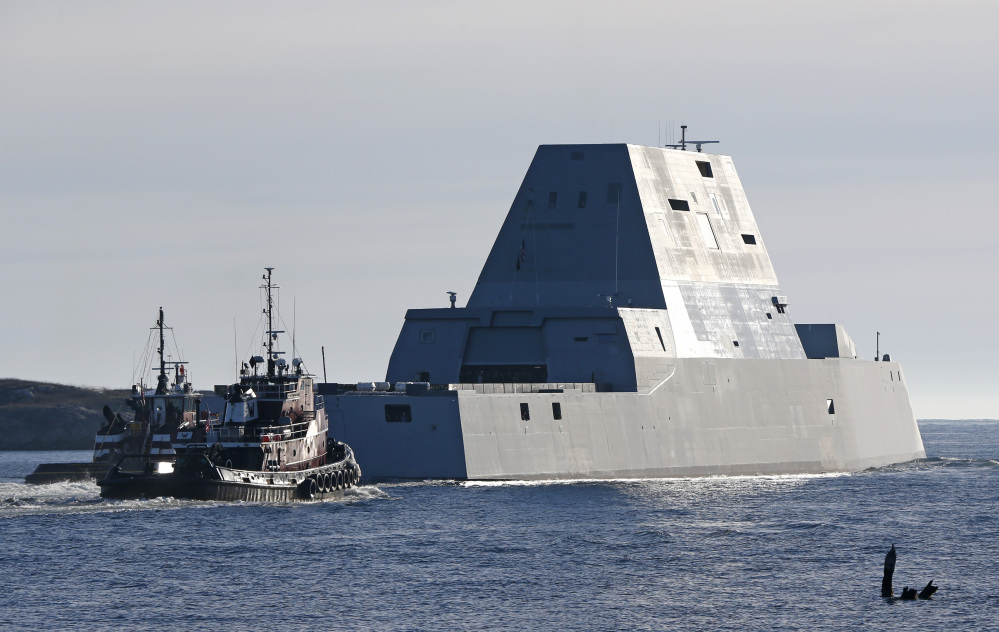April 14, 2014, U.S. Navy video. Vessel shown is a transport ship.
Two years ago, the Navy announced that it would test its futuristic rail gun in 2016 aboard a Joint High Speed Vessel, a new transport ship for which top admirals envision a variety of missions. The test would mark the first time the electromagnetic weapon – capable of firing rounds up to Mach 7 – would be fired at sea, “symbolizing a significant advance in naval combat,” Navy officials said.
With 2016 here, however, senior Navy officials appear to be moving off that testing plan. Adm. Pete Fanta, the Navy’s director of surface warfare, has proposed forgoing the testing and instead putting the gun directly on the future USS Lyndon B. Johnson, the third and final ship in the futuristic Zumwalt class of destroyers. It’s under construction at Bath Iron Works now, but is not expected to be completed until 2018.
BIW and the Navy invested an estimated $4.3 billion and more than four years building the USS Zumwalt, the first version of the next-generation “stealth” destroyer. The Zumwalt underwent sea trials in December.
The Associated Press published a story on the project this week, creating some buzz around the rail gun proposal. But the discussion has been ongoing for more than a month. Matt Leonard, a spokesman for Navy Sea Systems Command, told The Washington Post on Wednesday that the service is “studying the pros/cons of forgoing a 2016 at-sea demonstration” of the rail gun.
The shift, Leonard said, is under consideration with an eye toward accelerating testing of the rail gun and the “hypervelocity projectile” it fires, which also might be fired from conventional five-inch and 155mm naval guns.
Fanta told the independent Defense News newspaper late in December that he favored pushing back at-sea demonstrations rather than testing this year on an Expeditionary Fast Transport ship, the Navy’s new name for the Joint High Speed Vessel class. But the Navy won’t yet say whether that idea has won out.
“What I’m finding is if I go ahead with the demo it will slow my development,” Fanta told Defense News. “I would rather get an operational unit out there faster than do a demonstration that just does a demonstration.”
The Johnson has long been considered a front runner to carry that operational unit. More than a year ago, the commander of Naval Sea Systems Command, Vice Adm. William Hilarides, told USNI News that engineering studies were underway to make sure the ship had enough power, space and cooling to carry a rail gun. The first two ships in the class, the USS Zumwalt and the USS Michael Monsoor, were considered less likely homes for it because of the testing schedule for all three ships, which combined will cost at least $12.3 billion.
The Zumwalt class itself is just beginning to find its footing after a long period of research and building. The first ship was named after former Chief of Naval Operations Adm. Elmo Zumwalt. Its sea trials were considered a first step toward showing how the 610-foot-long, 15,480-ton destroyer can perform afloat despite having an unconventional pyramid-shaped hull that slopes out at the bottom with a stealthy “tumblehome” design. That should make it harder to find on radar, but also has long raised questions about how stable it will be when facing tough seas.
The Navy has said little about what it learned during those sea trials, which occurred from Dec. 7 to Dec. 13. Navy Capt. Thurraya Kent, a service spokeswoman, said in an email that personnel aboard tested several systems, carrying out operations involving small boats, anchors, propulsion and other systems.
“Primary risk reduction objectives were successfully met and, as with any trials, the Navy learned a great deal about ship performance during the more than 100 hours of extensive testing,” Kent said. The ship “will have additional at sea periods in the local operating area prior to delivery but dates are not releasable for force protection reasons.”
Copy the Story LinkSend questions/comments to the editors.



Success. Please wait for the page to reload. If the page does not reload within 5 seconds, please refresh the page.
Enter your email and password to access comments.
Hi, to comment on stories you must . This profile is in addition to your subscription and website login.
Already have a commenting profile? .
Invalid username/password.
Please check your email to confirm and complete your registration.
Only subscribers are eligible to post comments. Please subscribe or login first for digital access. Here’s why.
Use the form below to reset your password. When you've submitted your account email, we will send an email with a reset code.